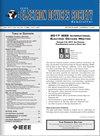Logic-Compatible Asymmetrical FET for Gain Cell eDRAM With Long Retention and Fast Access Speed
IF 2.4
3区 工程技术
Q3 ENGINEERING, ELECTRICAL & ELECTRONIC
引用次数: 0
Abstract
A novel Asymmetrical FET (AsyFET) is proposed to enhance the retention of gain cell memory and is experimentally demonstrated based on standard 300mm logic foundry platform. In AsyFET, the asymmetrical S/D doping and S/D gate spacer are designed to suppress leakage current. The modulated Schottky direct tunneling current and band-to-band tunneling current are designed to write “1” and “0” respectively without write disturb. The AsyFET-based 2T0C DRAM with significantly enhanced retention and fast access speed is also proposed and experimentally demonstrated on the same wafer. Without area penalty or new materials, the fabricated Si AsyFET can obtain ultralow off-state current of具有长保留和快速存取速度的增益单元eDRAM逻辑兼容非对称场效应管
提出了一种新的非对称场效应管(AsyFET),以提高增益单元记忆的保留,并在标准300mm逻辑代工平台上进行了实验验证。在AsyFET中,设计了不对称S/D掺杂和S/D栅极间隔来抑制泄漏电流。调制肖特基直接隧道电流和带间隧道电流被设计为分别写“1”和“0”而不产生写干扰。提出了一种基于asyfeet的2T0C DRAM,该DRAM具有显著增强的保留和快速的访问速度,并在同一晶圆上进行了实验验证。在没有面积损失和新材料的情况下,所制备的硅AsyFET可以获得$\sim 10{^{-}17 }$ A/ $\mu $ m的超低关态电流,从而在300mm晶圆上的55nm技术节点上长时间保持在秒级以上。在正向和反向偏置时,AsyFET的导通电流为$\sim 10{^{-}6 }$ A/ $\mu $ m,使写入速度低于5ns,温度依赖性可以忽略不计。实验结果表明,所提出的AsyFET 2T0C DRAM设计在低功耗、高密度和高速片上存储器方面具有很大的潜力。
本文章由计算机程序翻译,如有差异,请以英文原文为准。
求助全文
约1分钟内获得全文
求助全文
来源期刊

IEEE Journal of the Electron Devices Society
Biochemistry, Genetics and Molecular Biology-Biotechnology
CiteScore
5.20
自引率
4.30%
发文量
124
审稿时长
9 weeks
期刊介绍:
The IEEE Journal of the Electron Devices Society (J-EDS) is an open-access, fully electronic scientific journal publishing papers ranging from fundamental to applied research that are scientifically rigorous and relevant to electron devices. The J-EDS publishes original and significant contributions relating to the theory, modelling, design, performance, and reliability of electron and ion integrated circuit devices and interconnects, involving insulators, metals, organic materials, micro-plasmas, semiconductors, quantum-effect structures, vacuum devices, and emerging materials with applications in bioelectronics, biomedical electronics, computation, communications, displays, microelectromechanics, imaging, micro-actuators, nanodevices, optoelectronics, photovoltaics, power IC''s, and micro-sensors. Tutorial and review papers on these subjects are, also, published. And, occasionally special issues with a collection of papers on particular areas in more depth and breadth are, also, published. J-EDS publishes all papers that are judged to be technically valid and original.
 求助内容:
求助内容: 应助结果提醒方式:
应助结果提醒方式:


